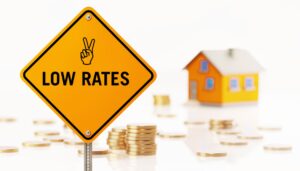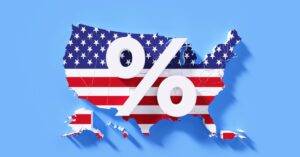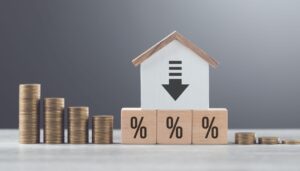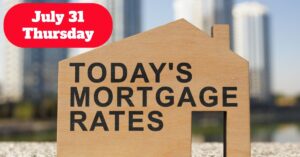As of August 1, 2025, mortgage rates and refinance rates have edged slightly higher across most loan types. The average 30-year fixed mortgage rate stands at 6.86%, up marginally from the previous week's 6.83%, and the 30-year fixed refinance rate increased to 7.07% from 7.04%. This rise reflects current economic conditions and the Federal Reserve's monetary policy stance, which has kept rates steady but signaled potential cuts later in the year.
Today's Mortgage Rates August 01, 2025: Rates Rise Marginally Across the Board
Key Takeaways
- 30-year fixed mortgage rate for August 1, 2025: 6.86% (up 3 basis points from last week).
- 15-year fixed mortgage rate increased slightly to 5.94%.
- 5-year ARM mortgage rate rose to 7.68%, indicating variable rates also climbed.
- 30-year fixed refinance rate reached 7.07%, up from 7.04%.
- Federal Reserve has paused rate hikes after multiple increases, with possible cuts expected later in 2025.
- Economic factors like inflation and GDP growth slowdown influence these rates.
- Borrowers should watch upcoming Fed meetings in September and December for rate movement clues.
Current Mortgage Rates by Loan Type
The mortgage market shows subtle upward movement after weeks of relative stability. Here's a detailed breakdown of conforming and government loan mortgage rates as of August 1, 2025:
| Loan Type | Rate | Change from Last Week | APR | APR Change from Last Week |
|---|---|---|---|---|
| Conforming Loans | ||||
| 30-Year Fixed | 6.86% | 0.00% | 7.28% | -0.04% |
| 20-Year Fixed | 6.50% | +0.12% | 6.95% | +0.17% |
| 15-Year Fixed | 5.94% | +0.04% | 6.21% | +0.01% |
| 10-Year Fixed | 5.94% | +0.19% | 6.34% | +0.22% |
| 7-Year ARM | 7.49% | +0.73% | 8.04% | +0.38% |
| 5-Year ARM | 7.68% | -0.05% | 7.93% | -0.10% |
| 3-Year ARM | — | 0.00% | — | 0.00% |
| Government Loans | ||||
| 30-Year Fixed FHA | 7.41% | 0.00% | 8.45% | 0.00% |
| 30-Year Fixed VA | 6.51% | +0.19% | 6.73% | +0.21% |
| 15-Year Fixed FHA | 5.67% | +0.16% | 6.63% | +0.12% |
| 15-Year Fixed VA | 6.05% | +0.20% | 6.42% | +0.22% |
Current Refinance Rates
Refinancing rates generally align with purchase mortgage rates but tend to be fractionally higher. Here’s an overview for August 1, 2025:
| Loan Type | Refinance Rate | Change from Last Week | APR | APR Change |
|---|---|---|---|---|
| 30-Year Fixed | 7.07% | +0.03% | — | — |
| 15-Year Fixed | 5.93% | +0.01% | — | — |
| 5-Year ARM | 7.95% | +0.02% | — | — |
Understanding What Drives Mortgage Rates in 2025
The Federal Reserve's monetary policy remains the largest influence on mortgage rates today. Following a period of aggressive rate increases during 2022 and 2023 to combat inflation, the Fed paused hikes in early 2025. As of July 30, 2025, the benchmark federal funds rate is 4.25%-4.5%, held steady for five consecutive meetings. Internal split opinions among Fed officials led to some dissent, signaling uncertainty about economic growth and inflation pressures.
Key Economic Metrics Influencing Mortgage Rates:
- Core Inflation (PCE): Still relatively stubborn at around 2.7%, keeping pressure on interest rates.
- GDP Growth: Slower growth at roughly 1.2% annualized for the first half of 2025.
- Unemployment Rate: Slight increase to about 4.5%, indicating some labor market softening.
With bond markets sensitive to Fed announcements and economic data, mortgage rates mirror these fluctuations closely. The 10-year Treasury yield—a good benchmark proxy—is hovering around 4.34%, influencing fixed mortgage rates.
How Borrowers Are Affected by the Current Rates
For homebuyers and those refinancing:
- Buyers are faced with mortgage rates near 7% for a 30-year fixed loan, higher than the ultra-low rates seen during the pandemic years but comparable to the 20-year highs of 2023.
- Refinancers with existing loans above 7% might consider waiting for the Fed's possible rate cuts expected later in 2025 to take advantage of lower rates.
- The variable rate mortgages (ARMs), such as the 5-year ARM at 7.68%, may suit some borrowers expecting rates to drop or planning shorter home tenure.
- Government-backed loans like FHA and VA offer slightly different rate profiles, with FHA 30-year fixed at 7.41% and VA 30-year fixed currently at 6.51%.
Example Calculation: Impact of Current 30-Year Fixed Mortgage Rate
Imagine a borrower takes a $300,000 mortgage with a 30-year fixed rate at today's average of 6.86%.
- Principal and interest monthly payment:
$$ P = \frac{r \times PV}{1 – (1 + r)^{-n}} $$where- $$r$$ = monthly interest rate = $$6.86\% / 12 = 0.00572$$
- $$PV$$ = loan amount = $300,000
- $$n$$ = total payments = 360 months
Calculating,
$$ P = \frac{0.00572 \times 300,000}{1-(1+0.00572)^{-360}} \approx 1,944.31 $$
The monthly payment for principal and interest is about $1,944.
If the rate was just 0.5% lower (6.36%), the payment would drop to approximately $1,880, saving about $64 monthly, illustrating how small rate changes significantly impact affordability.
Related Topics:
Mortgage Rates Trends as of July 31, 2025
Mortgage Rates Predictions for the Next 30 Days: July 22-August 22
The Federal Reserve's Upcoming Decisions Impacting Mortgage Rates
The Federal Reserve will reveal updated economic projections and likely discuss monetary policy direction in these key meetings:
- September 16-17, 2025: Market expects nearly a 50-50 chance of the Fed cutting rates to stimulate growth.
- December Meeting: The last likely opportunity for 2025 cuts, which could further reduce mortgage rates.
Should the Fed act on these cuts, mortgage rates may trend toward or below the 6% mark by the end of the year, providing relief for borrowers and refinancers alike.
Broader Market Context and Interest Rate Trends
While mortgage rates have climbed off pandemic lows, they remain historically moderate compared to the early 2000s. Years of Fed intervention, global economic disruptions, and inflation controlling measures have shaped the current rate environment.
Investors watch Treasury yields, inflation data, and labor market indicators closely, because these factors govern mortgage lending costs. Housing market activity often reacts to these shifts, influencing home prices, sales volume, and lending standards.
Summary Table of Key Mortgage and Refinance Rates Today
| Program | Rate (%) | 1-Week Change | APR (%) | APR 1-Week Change |
|---|---|---|---|---|
| 30-Year Fixed (Mortgage) | 6.86 | +0.03 | 7.28 | -0.04 |
| 15-Year Fixed (Mortgage) | 5.94 | +0.04 | 6.21 | +0.01 |
| 5-Year ARM (Mortgage) | 7.68 | +0.02 | 7.93 | -0.10 |
| 30-Year Fixed (Refinance) | 7.07 | +0.03 | — | — |
| 15-Year Fixed (Refinance) | 5.93 | +0.01 | — | — |
| 5-Year ARM (Refinance) | 7.95 | +0.02 | — | — |
This detailed overview of mortgage and refinance rates as of August 1, 2025, reflects a period of cautious stability with slight upward movements. Fed policy and economic signals hold the key to where rates head next, an essential consideration for buyers, refinancers, and real estate investors navigating today’s housing market.
Capitalize Amid Rising Mortgage Rates
With mortgage rates expected to remain high in 2025, it’s more important than ever to focus on strategic real estate investments that offer stability and passive income.
Norada delivers turnkey rental properties in resilient markets—helping you build steady cash flow and protect your wealth from borrowing cost volatility.
HOT NEW LISTINGS JUST ADDED!
Speak with a seasoned Norada investment counselor today (No Obligation):
(800) 611‑3060
Also Read:
- Will Mortgage Rates Go Down in 2025: Morgan Stanley's Forecast
- Mortgage Rate Predictions 2025 from 4 Leading Housing Experts
- Mortgage Rate Predictions for the Next 3 Years: 2026, 2027, 2028
- 30-Year Fixed Mortgage Rate Forecast for the Next 5 Years
- 15-Year Fixed Mortgage Rate Predictions for Next 5 Years: 2025-2029
- Will Mortgage Rates Ever Be 3% Again in the Future?
- Mortgage Rates Predictions for Next 2 Years
- Mortgage Rate Predictions for Next 5 Years
- Mortgage Rate Predictions: Why 2% and 3% Rates are Out of Reach
- How Lower Mortgage Rates Can Save You Thousands?
- How to Get a Low Mortgage Interest Rate?
- Will Mortgage Rates Ever Be 4% Again?










